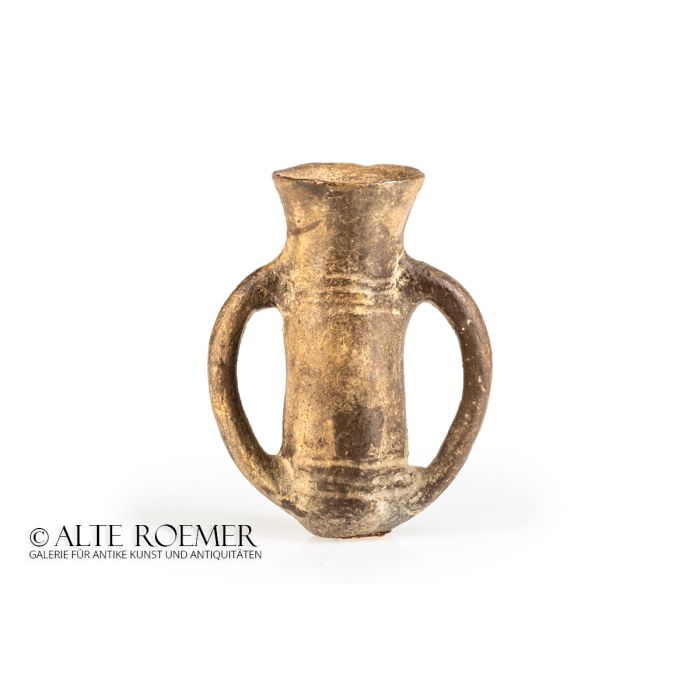Driking cup of the Troy type
Price: on request
Sold
Object number
AR3137
| Object: |
Two handled driking cup
|
| Material: |
Clay with dark brown slip
|
| Period: |
Early Bronze Age III, the last phase of the Early Bronze Age in Western and Central Anatolia. This type of vessel is clasically associated to phase II of Troy, as described in Homer's Iliad. The exact dating depends slighly on the find region, but in any case a date around 2500 BC or a bit later is accurate. |
| Description: |
Slender cup with two handles. The body is hand-formed, without a potter's wheel, of cylindrical shape with a slightly opening mouth. It is decorated with three transverse grooves at two different heights. The large handles with circular cross-section run in an arc from below the mouth to the foot. The type of vessel is known in archaeology as Depas Amphikypellon, and also as Troy Cup. |
| Background: |
This type of vessel was first discovered by the infamous archaeologist Heinrich Schliemann in phase IIc of the Troy excavation (find number A45). He was convinced it is one of the drinking cups mentioned in Homer's Iliad. He named them Depas Amphikypellon, which can be loosely translated as two handled driking cup. The cups imitate metal vessels and must have belonged to the elite of Troy, Anatolia and beyond. They came up during a turning point in history. Social differences grew and a political elite formed. At the same time, eating and drinking habits changed. The depas vessels entered the scene together with a new drink, wine. Latest archaeometric studies by Türkteki et al. confirm that the depas really contained wine (see literature reference below). But they also contained certain herbs that would have a soothing effect together with the alcohol. An elite ritual where participants would drink wine and herbs from a Depas Amphikypellon and then dispose of the vessel could therefore also be interpreted as a mourning ceremony to ease the sadness and pain. Modern research revealed many new facts about the depas cups since they first came up in the Troy excavation. What would an archaeologist with the passsion and imagination of Heinrich Schliemann make of the new situation? It would certainly be a thrilling tale about the Troyan war heroes Homer described. Therefore, we take this cup and propose a toast to Mr. Schliemann. |
| Dimensions: |
10.5cm high, 7.6cm wide including handles.
|
| Condition: |
Very good condition. Unobtrusive restoration to the handles, otherwise perfectly preserved. Adhesive put on the bottom by a previous owner to make the cup stand on its own.
|
| Provenance: |
Acquired by us in 2021 from the German private collection G. Damerow. Acquired into the collection between 1980 and 1985 at auction house Schwarzer Baer Roland A. Exner, Hanover, Germany.
|
| References: |
Cf. A. Türker, Suluca Karahöyük: A commercial context in central cappadocia in light of depas amphikypellon findings and foot-shaped stamp seal, 23 (2019), pp. 54-65, fig. 7, Sk-3 (Hb/h-58, Nr. 962), layer Vb. Cf. Collection of the Archaeological Institute of Goettingen University, acc. no. TRG 40. |
| Literature: |
A very good summary of the state of knowledge and the new archaeometric investigations mentioned above can be found in the article M. Türkteki et al., Possible uses of Depas Amphikypellon from Küllüoba in Western Central Anatolia through GC-MS analysis of organic residues, in Mediterranean Archaeology and Archaeometry, vol. 22, no. 1, (2022), pp. 127-154.
|
| Authenticity: |
We unconditionally guarantee the authenticity of every artefact, all items are subject to our lifetime return policy on authenticity.
|


